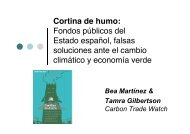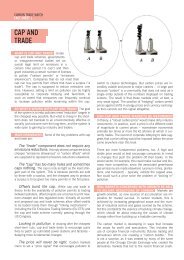3.2 Renewables under SiegeEm<strong>is</strong>sions trading threatens to reducesustainable renewable energy to adecorative by-product. <strong>The</strong> projectrequirements of CDM and JI containobstacles for small renewable projects.<strong>The</strong>se include difficulties in measuringand determining ownership of energyproduction. 1 Large multi-nationalcorporations find it easier to overcome<strong>the</strong>se obstacles than smaller firms.Companies such as Shell orBPAmoco, which have both renewableand fossil-fuelled facilities can offsetwithin one corporate structure, haveclear ownership and can achieveem<strong>is</strong>sions reductions which are easierto measure.<strong>The</strong> Dutch Government’s CDMprogramme will pay up to US$5.00 for permits fromrenewable projects. 4 However,permits from sinks projects in<strong>the</strong> South could cost as littleas US $1.00. 5Renewable firms may find that <strong>the</strong>best prices for permits will not comefrom demand to fulfil Kyoto reductiontargets, but from companies wanting tobuy permits to build anenvironmentally friendly image.Frank Van Der Vleuten of Free EnergyEurope, a manufacturer of solarpanels, believes that, “<strong>The</strong> Kyotomechan<strong>is</strong>ms are far away frompractical application and relevance.Hardly anybody has a v<strong>is</strong>ion how <strong>the</strong>ycan be put into practice for smallrenewable energy systems.” He adds“before establ<strong>is</strong>hing abstract marketbased mechan<strong>is</strong>ms, <strong>the</strong> first and mostsignificant step <strong>is</strong> recogn<strong>is</strong>ing <strong>the</strong> realand many values of renewable energywhich go beyond <strong>the</strong> cost of oneem<strong>is</strong>sion reduction permit.” 6When large companies have superioraccess to subsidies, smallercompanies find <strong>the</strong>mselves at acompetitive d<strong>is</strong>advantage. Th<strong>is</strong>undermines diversity and innovation in<strong>the</strong> renewable energy sector as awhole. In <strong>the</strong> Ne<strong>the</strong>rlands, subsidiesfor <strong>the</strong> solar industry in <strong>the</strong> 1990s wereconcentrated on Shell and ecoconsultantsEcofys. 2 Th<strong>is</strong> limited <strong>the</strong>number of solar panel firms to just afew main players and Shell gained avirtual monopoly in solar panelinstallation. In contrast, Germansubsidies were d<strong>is</strong>tributed more fairlyacross different sized firms. By 2002<strong>the</strong>re were over 300 companiesinvolved in supplying solar panels. 3A coal-fired power plant would find itmore rational to introduce energyefficiency measures or switch to gas,than to replace <strong>the</strong> use of fossil fuelswith a wind farm.“Most of <strong>the</strong> running for<strong>the</strong> CDM <strong>is</strong>, sadly, likelyto be made by bigcompanies offeringmarginally cleaner coalcombustion kits toChina.”— Professor David Elliot,Energy & EnvironmentResearch Unit, OpenUniversity, UK. 722
4. Kyoto in Context: <strong>Trade</strong> andInvestmentAs em<strong>is</strong>sions trading emerges as aprinciple component of governmentclimate change policy, <strong>the</strong> rulesgoverning its use will have to cohabitwith rules governing trade andinvestment. Increasingly, <strong>the</strong>se tradeand investment rules continue todevelop and expand in scope andpower affecting more and moreaspects of human activity. Any effortsto improve <strong>the</strong> rules of em<strong>is</strong>sionstrading, or to curb its use, will beforced to contend with <strong>the</strong>se forces ofliberal<strong>is</strong>ation.As new international‘environmental markets’develop, in what way will<strong>the</strong>se markets be subjectto international rulesgoverning trade andinvestment? <strong>The</strong> KyotoProtocol, for example,includes three marketbasedmechan<strong>is</strong>ms(CDM, JI, and Em<strong>is</strong>sionsTrading), which intersectwith many ex<strong>is</strong>ting rules in <strong>the</strong> World<strong>Trade</strong> Organ<strong>is</strong>ation (WTO). As such,speculation <strong>is</strong> rife over how <strong>the</strong>relationship between WTO rules and<strong>the</strong> Kyoto Protocol will pan out.Free <strong>Trade</strong> in Greenhouse Gases?<strong>The</strong> WTO governs international tradingrelationships between countries byenforcing complex rules, which extendbeyond mere trade in goods to coverservices, intellectual property rights,trade-related aspects of investment,agriculture, government procurement,and more. <strong>The</strong> WTO also includes ad<strong>is</strong>pute settlement mechan<strong>is</strong>m, whichenables it to enforce non-complianceof its rules with devastating tradesanctions and penalties. Variousmin<strong>is</strong>terial ‘rounds’ in <strong>the</strong> WTOcontinue to expand and refine <strong>the</strong>serules to cover ever more aspects ofglobal economic activity, with <strong>the</strong>ultimate goal of securing global free“<strong>The</strong> Kyoto Protocol to<strong>the</strong> UN FrameworkConvention on ClimateChange (FCCC) may be<strong>the</strong> most importanteconomic agreementpenned in <strong>the</strong> 20thcentury.”— Aaron Cosbey, Royal Institute ofInternational Affairs (RIIA) 1trade, property protection, supranationalregulation of <strong>the</strong> economy,and d<strong>is</strong>pute settlement for <strong>the</strong> globaleconomy.Since <strong>the</strong> rules for <strong>the</strong> Kyotomechan<strong>is</strong>ms are still being developed,and <strong>the</strong> WTO’s Committee on <strong>Trade</strong>and Environment (<strong>the</strong> principalcommittee responsible for evaluating<strong>the</strong> relationship between MultilateralEnvironmental Agreements (MEAs)such as <strong>the</strong> Kyoto Protocol, and <strong>the</strong>WTO), <strong>is</strong> still deliberating, muchremains speculation. Sinceinternational em<strong>is</strong>sions trading,particularly with regard to <strong>the</strong> KyotoProtocol, will have alarge impact on globaleconomic activity, <strong>the</strong>re<strong>is</strong> already a broadconsensus among legalexperts and academicsthat <strong>the</strong>re are somepoints of conflict, whichwill need to beaddressed. 2<strong>The</strong>se include <strong>is</strong>suessuch as: subsidies forrenewable energy technologies,d<strong>is</strong>crimination of products based onhow <strong>the</strong>y are produced, labellingstandards, environmental and socialstandards included in CDM and JI, <strong>the</strong>nature of certain types of rules whichmay be imposed on em<strong>is</strong>sionsmarkets to prevent fraud, ‘carbontaxes’ and cross-border adjustments.In all <strong>the</strong>se areas and more, <strong>the</strong>re areconcerns that WTO rules restrictcountries from fulfilling key parts of <strong>the</strong>Kyoto Protocol. <strong>The</strong>re has alreadybeen a glimpse of th<strong>is</strong>, when in 1999,<strong>the</strong> US Clean Air Act prov<strong>is</strong>ionrestricting imports of low standardreformulated gasoline was struckdown by <strong>the</strong> WTO in a challenge. As aresult, <strong>the</strong> US EnvironmentalProtection Agency was forced torewrite <strong>the</strong> rules to be in compliancewith <strong>the</strong> WTO ruling. <strong>The</strong> measurewas aimed at meeting tougher airquality standards by preventing <strong>the</strong>use of low-grade gasolines. 323











